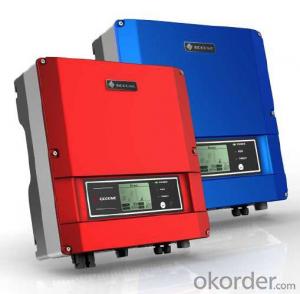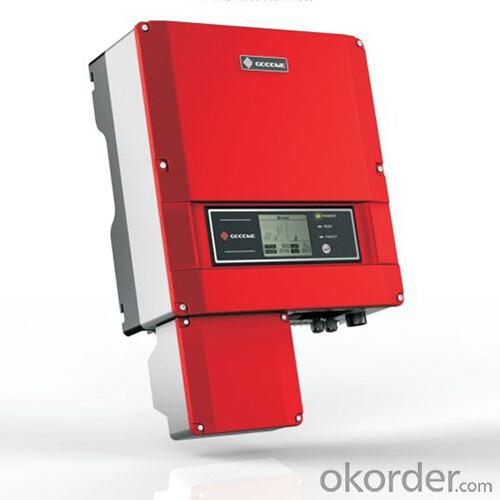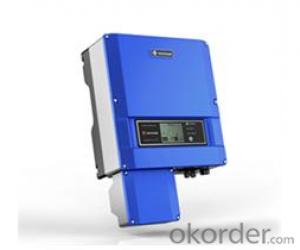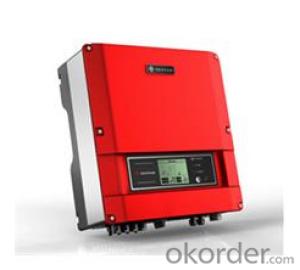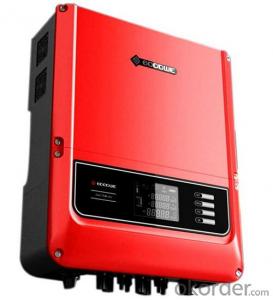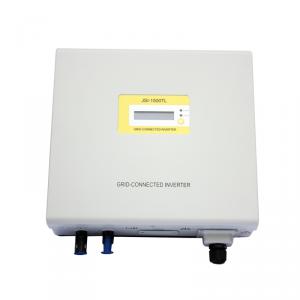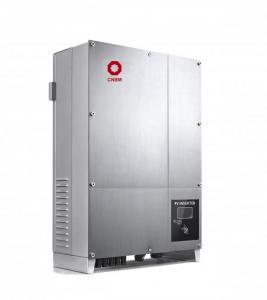15 Kw Solar Inverter GW3600D-DI (High Frequency Isolated)
- Loading Port:
- Shanghai
- Payment Terms:
- TT OR LC
- Min Order Qty:
- 12 pc
- Supply Capability:
- 1000 pc/month
OKorder Service Pledge
OKorder Financial Service
You Might Also Like
GW3000/3600/4200D-DI (High Frequency Isolated)
1.SPECIFATION
is the new on-grid PV inverter which integrated with most advanced technology, come with 10 years warranty,
and are designed to meet the new IEE1547 requirements for the North American market. Also it’s suitable for thick-film modules.
Easy installation and simple operation make them ideal for residential and small-to-medium commercial applications.
GoodWe inverters, with ever-increasing efficiency and high stability,
could ensure you better overall performance of solar power systems and shorter payback periods.
2.Datasheet
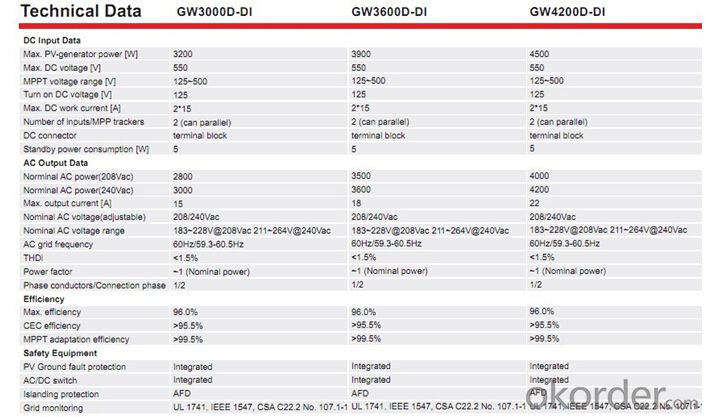
3. Solar inverter certification
EN 61000
VDE 0126-1-1
C10/11
G83/2
UTE C15-712-1
AS4777
CQC
CE10-21
EN50438
4.solar inverter picture
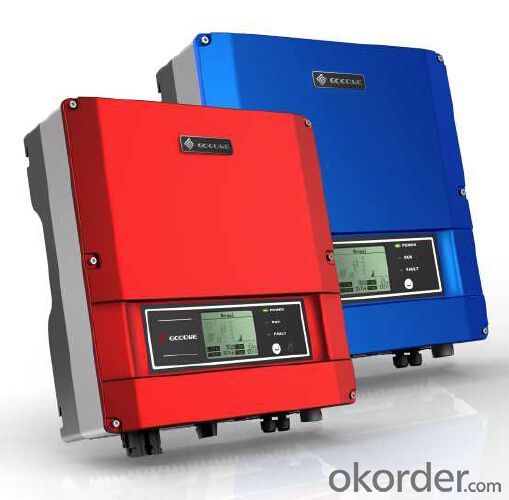
FAQ
1. What price for each watt?
It depends on the efficiency of the solar cell, quantity, and delivery date and payment terms.
2. How long can we receive the product after purchase?
In the purchase of product within three working days, We will arrange the factory delivery as soon as possible. The pacific time of receiving is related to the state and position of customers. Commonly 7 to 10 working days can be served.
We can provide you not only the solar material but also the off grid solar system, we can also provide you service with on grid plant.
4. How do you pack your products?
We have rich experience on how to pack the solar cell to make sure the safety on shipment; we could use wooden box or pallet as buyer's preference.
5. Can you do OEM for us?
Yes, we can.
- Q: Can a solar inverter be used for off-grid systems?
- Yes, a solar inverter can be used for off-grid systems. In fact, it is an essential component of off-grid solar systems as it converts the DC (direct current) electricity generated by the solar panels into AC (alternating current) electricity that can be used to power household appliances and other electrical devices.
- Q: How does a solar inverter handle variations in ambient temperature?
- A solar inverter handles variations in ambient temperature by incorporating temperature compensation mechanisms. These mechanisms allow the inverter to adjust its operation and optimize performance based on the temperature conditions. By monitoring the temperature, the inverter can regulate voltage levels, adjust power outputs, and protect itself from overheating. This ensures that the inverter operates efficiently and reliably under different ambient temperature conditions.
- Q: Photovoltaic grid-connected inverter without DC emc how will happen
- light is obtained by the electrons of the semiconductor device, thus generating electrical energy. This energy conversion of light energy into energy, that is, solar cells. Solar cells, like transistors, are made of semiconductors. Its main material is silicon, and there are some other alloys. High-purity silicon used in the manufacture of solar cells is subject to special purification. Solar cells as long as the sun or light exposure,
- Q: Can a solar inverter be integrated with smart home systems?
- Yes, a solar inverter can be integrated with smart home systems. Smart home systems allow for the monitoring and control of various devices and appliances, including solar inverters. By integrating a solar inverter with a smart home system, users can monitor the performance of their solar panels, track energy production, and even remotely control the inverter settings. This integration enables homeowners to optimize their energy usage, increase efficiency, and seamlessly manage their solar energy systems.
- Q: How do you connect solar panels to a solar inverter?
- To connect solar panels to a solar inverter, you need to follow a few steps. First, ensure that the solar panels are properly installed and positioned to receive maximum sunlight. Then, connect the positive and negative terminals of each solar panel in series or parallel, depending on the system design. Next, connect the positive and negative terminals of the solar panel array to the input terminals of the solar inverter. Finally, double-check all connections and wiring to ensure they are secure and tight.
- Q: Can a solar inverter be used in areas with high dust and dirt accumulation?
- Yes, it is possible to use a solar inverter in areas where there is a high accumulation of dust and dirt. However, it is important to take specific precautions and maintenance measures to guarantee its proper operation. Over time, dust and dirt can build up on the surface of the solar panels, causing a decrease in their efficiency. This can also have an impact on the performance of the solar inverter, as it relies on the energy produced by the solar panels. To minimize the impact of dust and dirt, it is essential to regularly clean the solar panels. This can be accomplished by using a gentle brush or sponge along with a mild detergent mixed with water. It is important to avoid using abrasive materials or applying excessive water pressure, as this may cause damage to the panels. Additionally, installing the solar panels at an angle and orienting them towards the sun can aid in reducing the accumulation of dust and dirt. Furthermore, some solar inverters are designed with built-in protection against dust and dirt. These inverters typically have IP65 or higher ratings, which indicates that they are dust-resistant and capable of withstanding water jets. Opting for such inverters can provide an extra layer of protection against the negative effects of dust and dirt accumulation. Overall, while it is possible to use a solar inverter in areas with high dust and dirt accumulation, regular maintenance and proper cleaning of the solar panels are crucial to ensure optimal performance and longevity of the system.
- Q: What is the role of reactive power control in a solar inverter?
- The role of reactive power control in a solar inverter is to manage and regulate the flow of reactive power in the electrical system. It helps to maintain a stable voltage level, improve power factor, and ensure efficient operation of the solar inverter. By controlling reactive power, the inverter can mitigate voltage fluctuations and provide optimal power quality, making the system more reliable and compliant with grid requirements.
- Q: How do you connect a solar inverter to the electrical grid?
- To connect a solar inverter to the electrical grid, you typically follow a few steps. First, ensure that your solar panels are properly installed and generating electricity. Then, connect the DC output of the solar panels to the DC input of the inverter. Next, connect the AC output of the inverter to your home's electrical distribution panel or directly to the electrical grid through a utility meter. Finally, consult with a qualified electrician to ensure that the installation meets all relevant safety and electrical codes.
- Q: Can a solar inverter be used in systems with different module tilts?
- Yes, a solar inverter can be used in systems with different module tilts. Solar inverters are designed to convert the DC power generated by solar panels into AC power for use in the electrical grid. They are compatible with a wide range of module tilts and orientations, allowing flexibility in system design and installation.
- Q: Can a solar inverter be used with different AC voltages?
- Yes, a solar inverter can be used with different AC voltages. However, it is important to ensure that the inverter is compatible with the specific AC voltage and frequency requirements of the power grid it will be connected to.
Send your message to us
15 Kw Solar Inverter GW3600D-DI (High Frequency Isolated)
- Loading Port:
- Shanghai
- Payment Terms:
- TT OR LC
- Min Order Qty:
- 12 pc
- Supply Capability:
- 1000 pc/month
OKorder Service Pledge
OKorder Financial Service
Similar products
Hot products
Hot Searches
Related keywords


